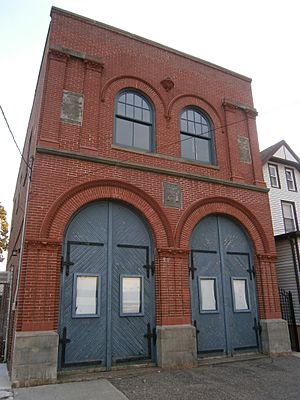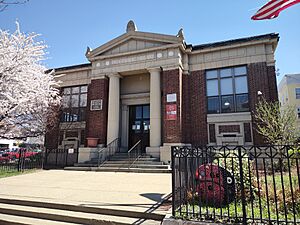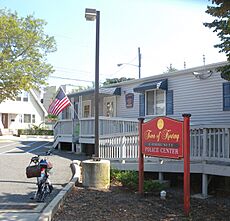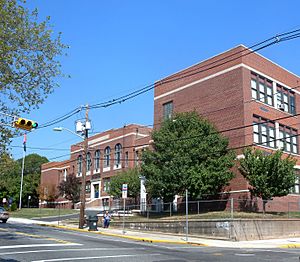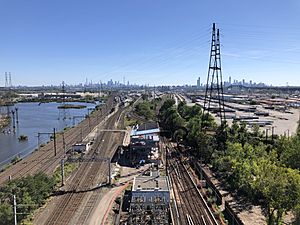Kearny, New Jersey facts for kids
Quick facts for kids
Kearny, New Jersey
|
|||
|---|---|---|---|
|
Town
|
|||
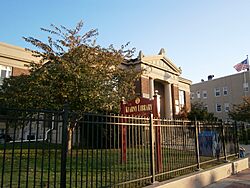
Kearny Library and Museum, November 2011
|
|||
|
|||
| Nickname(s):
Soccer Town, U.S.A.; K-Town
|
|||
| Country | |||
| State | |||
| County | |||
| Incorporated | April 8, 1867 | ||
| Named for | Philip Kearny | ||
| Government | |||
| • Type | Town | ||
| • Body | Town Council | ||
| Area | |||
| • Total | 10.27 sq mi (26.61 km2) | ||
| • Land | 8.84 sq mi (22.91 km2) | ||
| • Water | 1.43 sq mi (3.70 km2) 13.91% | ||
| Area rank | 209th of 565 in state 3rd of 12 in county |
||
| Elevation | 7 ft (2 m) | ||
| Population
(2020)
|
|||
| • Total | 41,999 | ||
| • Estimate
(2023)
|
39,370 | ||
| • Rank | 54th of 565 in state 7th of 12 in county |
||
| • Density | 4,748.9/sq mi (1,833.6/km2) | ||
| • Density rank | 122nd of 565 in state 11th of 12 in county |
||
| Time zone | UTC−05:00 (Eastern (EST)) | ||
| • Summer (DST) | UTC−04:00 (Eastern (EDT)) | ||
| ZIP Codes |
07032, 07099
|
||
| Area code(s) | 201 and 973 | ||
| FIPS code | 3401736510 | ||
| GNIS feature ID | 0885266 | ||
Kearny (pronounced KAR-nee) is a town located in the western part of Hudson County, New Jersey. It's considered a suburb of Newark. In 2020, the town had a population of 41,999 people.
Kearny is named after Civil War General Philip Kearny. It started as a "township" (a type of local government area) on April 8, 1867. This was created from parts of Harrison Township. Later, on January 19, 1899, Kearny officially became a "town" after people voted for the change. The area called Arlington in Kearny got its name from a train station near the Arlington Mill plant.
Contents
Exploring Kearny's Past
Kearny's Early Beginnings
The land that became Kearny was part of a large grant of about 30,000 acres given to Major William Sandford in 1668. He called it New Barbadoes Neck. Sandford bought the land from Chief Tantaqua of the Hackensack tribe.
Later, in 1708, Major Nathaniel Kingsland owned the property. He sold a large part of it to Captain Arent Schuyler in 1710. This new land included what is now Kearny, North Arlington, Lyndhurst, and Kingsland.
A special green stone was found on Schuyler's land. It turned out to be 80% copper! Schuyler opened a copper mine, which brought the first steam engine to America from England. This engine was used to pump water out of the deep mine. The engine and mines were destroyed by fire in 1772.
Schuyler Mansion was important during the American Revolutionary War. British officers often visited because it was close to New York Harbor. In September 1777, British General Henry Clinton even used the mansion as his headquarters. The mansion stood for 214 years until it was taken down in 1924 for new development.
Kearny in the 1800s
In the mid-1800s, Kearny was the northern part of Harrison Township. General N. M. Halsted, a local leader, believed his area needed its own government. He worked hard to create an independent township. On April 8, 1867, Kearny Township was officially formed. It was named after Major General Philip Kearny, a Civil War commander who owned a mansion nearby called "Belle Grove."
The first town election was held on April 8, 1867, and General Halsted was chosen as Chairman. The first government office was in the old Lodi Hotel.
Kearny built its first Town Hall in the early 1870s. This building also served as a courthouse and schoolhouse. In 1870, the town began to set up its public school system. The first school was in the Town Hall, built in 1873.
The Highland Hose No. 4 firehouse, a historic building, was built in 1895.
Kearny is known as "Soccer Town, U.S.A." This nickname comes from a soccer tradition that started in the 1870s. Thousands of Scottish and Irish immigrants moved to Kearny when two Scottish companies, Clark Thread Company and Nairn Linoleum, opened factories there. Many of these immigrants loved soccer and played on local teams.
The current Kearny Town Hall, made of Indiana limestone, was built in 1909 because the town needed more space.
Kearny as a Factory Town
Industries began to grow in Kearny around 1875. The Clark Thread Company from Scotland built two large mills in Kearny. These mills brought many Scottish immigrants to the town. Many of them played on Kearny's soccer teams.
In 1876, the Mile End Thread Mills also opened, providing many jobs. In 1883, the Marshall Flax Spinning Company from England built a large factory, known as the Linen Thread Company. This brought more skilled workers from the British Isles. These early textile workers and their families became a core part of Kearny's population.
Other companies also set up in Kearny, including the Puraline Manufacturing Company (later DuPont) and the Nairn Linoleum Company in 1887. This led to a large Scottish American population in Kearny, making up more than half of the residents in the 1960s.
During World War I and World War II, cargo and warships were built at Kearny Yards.
Western Electric's Kearny Works
On June 15, 1928, Western Electric started building a large manufacturing plant at 110 Central Avenue, known as Kearny Works. This plant grew to be 3,579,000 square feet.
Between 1925 and 1986, the Kearny Works of Western Electric employed up to 24,000 people. They made various parts and supplies for the Bell System (a telephone company). In 1984, AT&T sold the plant. At that time, it had 4,000 employees and was one of the county's biggest employers. The plant closed in 1986.
Kearny in Movies and TV
Kearny has been a filming location for movies and TV shows.
- In 1982, the movie Annie filmed scenes at the abandoned NX Bridge over the Passaic River. Locals sometimes call it the "Annie Bridge."
- Scenes from the HBO drama series The Sopranos were also filmed in Kearny.
- The film Spinning Gold had scenes filmed in Kearny.
- The 2022 horror movie Smile filmed a scene at Jersey Oil in Kearny.
Kearny Point now has two studios for film and television production. This helps create jobs and brings more business to the community.
Entertainment Venues
Kearny once had several movie theaters, especially in the early 1900s. Many of these early theaters were later changed into apartments or meeting places. The Lincoln Theater operated until August 2015. It was sold in September 2022, and the new owner plans to turn it into apartments. Currently, there are no movie theaters operating in Kearny.
Here is a list of some former theaters:
| Name | Address | Built | Seats | Closure | Current Status |
|---|---|---|---|---|---|
| Arlington Playhouse | Kearny and Midland Ave | 1912 | Closed | Closed | |
| Crescent | Midland Ave between Forest and Elm Streets | 1908 | ? | 1914 | Closed |
| The Grand | 25 Kearny Ave | ? | Closed | Currently an apartment building | |
| The Casino | 95 Kearny Ave | ? | Closed | Currently Irish-American Club | |
| The Temple | 225 Kearny Ave | ? | Closed | Currently the Copestone Masonic Temple | |
| Hudson Theatre | 65 Kearny Avenue | 1927 | 1,491 | 1950 | Closed, current as Kearny Family Health Center |
| Lincoln Cinemas | 838 Kearny Avenue | 1934 | 1,267 | 1995 | Closed, building sold 2022 |
| Regent Theater | 413 Kearny Avenue and Grove Street | 1922 | 1,781 | mid 1950s- | Closed |
Kearny's Location and Landscape
Kearny covers about 10.27 square miles, with 8.84 square miles of land and 1.43 square miles of water.
Some smaller communities and places within Kearny include Arlington, New Jersey, Schuylers Corner, and West Arlington.
Kearny shares borders with East Newark and Harrison in Hudson County. It also borders Lyndhurst and North Arlington in Bergen County. The Passaic River separates Kearny from Newark and Belleville in Essex County. The Hackensack River separates it from Secaucus and Jersey City.
The town has different types of land, generally divided into three parts: the Kearny Uplands (higher ground), the Kearny Meadows (flat, low-lying areas), and South Kearny, where the Hackensack and Passaic rivers meet. Important roads include Kearny Avenue, Bergen Avenue, Midland Avenue, Schuyler Avenue, and Passaic Avenue.
Several small parks along the Passaic River are known as Riverbank Park. The largest park is West Hudson Park, which Kearny shares with Harrison. It has sports fields, recreation areas, and an artificial pond. The Kearny Playground at Gunnel Oval is another large recreational area.
Population and People
| Historical population | |||
|---|---|---|---|
| Census | Pop. | %± | |
| 1880 | 777 | — | |
| 1890 | 7,064 | 809.1% | |
| 1900 | 10,896 | 54.2% | |
| 1910 | 18,659 | 71.2% | |
| 1920 | 26,724 | 43.2% | |
| 1930 | 40,716 | 52.4% | |
| 1940 | 39,467 | −3.1% | |
| 1950 | 39,952 | 1.2% | |
| 1960 | 37,472 | −6.2% | |
| 1970 | 37,585 | 0.3% | |
| 1980 | 35,735 | −4.9% | |
| 1990 | 34,874 | −2.4% | |
| 2000 | 40,513 | 16.2% | |
| 2010 | 40,684 | 0.4% | |
| 2020 | 41,999 | 3.2% | |
| 2023 (est.) | 39,370 | −3.2% | |
| Population sources: 1880–1920 1880–1890 1890–1910 1900–1930 1940–2000 2000 2010 2020 |
|||
Population in 2010
In 2010, Kearny had 40,684 people living in 13,462 households. About 33.5% of households had children under 18. The average household had 2.83 people.
The population was diverse: 73.57% White, 5.37% Black or African American, 4.41% Asian, and 12.53% from other races. About 39.95% of the population was Hispanic or Latino.
The median age in Kearny was 36.4 years.
Population in 2000
In 2000, Kearny had 40,513 people. About 34.6% of households had children under 18. The average household had 2.81 people.
The racial makeup was 75.75% White, 3.97% African American, 5.50% Asian, and 10.04% from other races. About 27.34% of the population was Hispanic or Latino.
The median age was 35 years.
Kearny's Economy
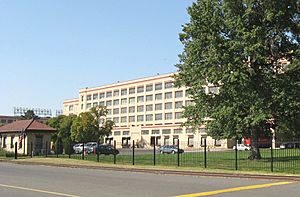
The Western Electric Kearny Works plant was a major taxpayer for the town. When it closed in 1986, Kearny officials worked to attract new businesses to make up for the lost tax money.
Parts of Kearny are in an Urban Enterprise Zone (UEZ). This program helps encourage jobs and investment in certain areas. Shoppers in these zones can pay a reduced sales tax rate (3.3125% instead of the usual 6.625%). Kearny became a UEZ in 1983, and its status is set to expire in November 2023. Since it started, the UEZ has brought in $27 million in tax revenue for the town.
Arts and Culture in Kearny
The Kearny Public Library is one of New Jersey's Carnegie libraries. It has a museum on its third floor that shows exhibits about Kearny's history and culture. The museum also has items related to the town's namesake, Philip Kearny.
In 2023, the town bought a former church for $1.5 million. They plan to turn it into a cultural center for the community.
How Kearny is Governed
Local Government Structure
Kearny is governed as a "Town" under New Jersey's municipal government system. The town is led by a Mayor and a Town Council. The Mayor is elected by all voters for a four-year term. The Town Council has eight members, elected from four different areas called "wards." Two council members are elected from each ward for four-year terms, with elections happening in a staggered way.
The Mayor and Council make laws and policies for the town. The day-to-day operations are managed by the Town Administrator, who follows the policies set by the Mayor and Council.
The current Mayor of Kearny is Carol Jean Doyle, who was elected to finish a term ending December 31, 2025. She is an Independent politician. The Town Council members are Renato da Silva (3rd Ward), Marytrine De Castro (1st Ward), Eileen Eckel (3rd Ward), Gerald J. Ficeto (4th Ward), Richard P. Konopka (2nd Ward), Dennis Solano (2nd Ward), Stathis Theodoropoulos (4th Ward), and George Zapata (1st Ward).
In July 2023, Peter Santana was appointed Mayor temporarily after Mayor Al Santos resigned to become a judge. In November 2023, Carol Jean Doyle won the special election, becoming the first woman to serve as Kearny's mayor.
Fire Department Services
The Kearny Fire Department protects the town. It operates from four fire stations. Steve Dyl is the current Chief of Department.
Here are the locations and equipment of the Kearny Fire Department:
| Engine company | Ladder company | Special unit | Command unit | Address |
|---|---|---|---|---|
| Engine 1 | Quick Attack Response Vehicle 1 (QRV), Two flood rescue boats (Zodiacs) | 47 Davis Avenue | ||
| Squad 2 (Rescue Pumper), Engine 6 (spare) | Ladder Tower 2 | Rescue 2 (cross staffed) | Car 2 (Deputy Chief) | 109 Kearny Avenue |
| Engine 3, Engine 5 (Spare) | Ladder Tower 1 (Spare) | Service 3 (Utility Truck), Marine 3 (Fireboat) | Car 3 (Safety Officer) | 109 Midland Avenue |
| Engine 4 | Foam Unit 1, MPV 4 (Multi Purpose Vehicle), Haz-Mat Decon Trailer | 83 John Miller Way |
Political Representation
Kearny is divided between two Congressional Districts: the 8th and 9th. It is also part of New Jersey's 31st state legislative district.
Political Trends
As of March 2011, Kearny had 16,348 registered voters. Most voters were registered as Democrats (43.0%) or Unaffiliated (45.2%). Only 11.8% were registered as Republicans.
In recent presidential elections, Kearny voters have mostly supported Democratic candidates. For example, in the 2020 election, Democrat Joe Biden received 59.4% of the vote. In the 2016 election, Democrat Hillary Clinton received 62.4% of the vote.
Learning in Kearny
Public Schools in Kearny
The Kearny School District serves public school students from pre-kindergarten through twelfth grade. In the 2021–22 school year, the district had 5,142 students across seven schools. The student-teacher ratio was about 11.3 students per teacher.
The schools in the district include:
- Franklin Elementary School (PreK-6)
- Garfield Elementary School (PreK-6)
- Roosevelt Elementary School (PreK-6)
- Schuyler Elementary School (PreK-6)
- Washington Elementary School (PreK-6)
- Lincoln Middle School (7-8)
- Kearny High School (9-12)
Charter Schools
Kearny also has Hudson Arts and Science Charter School (HASCS), which is part of iLearn Schools. HASCS has two campuses: an elementary school (grades K-3) at 131 Midland Avenue and a middle school (grades 4-8) at 114 Chestnut Street. Together, they serve 815 students.
Private Schools in Kearny
Some private schools in Kearny are:
- Kearny Christian Academy (Kindergarten-12th grade)
- The Little Neighborhood Learning Center
- Happy Time Preschool & Day Care
Mater Dei Academy, a former Catholic school, closed at the end of the 2011–2012 school year due to fewer students.
Getting Around Kearny
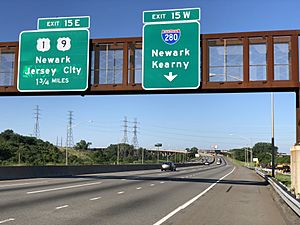
Roads and Highways
As of 2010, Kearny had about 70.89 miles of roads. Most of these (50.75 miles) are maintained by the town.
Several major roads pass through Kearny:
- The Belleville Turnpike (Route 7) forms the northern border with North Arlington.
- Kearny Avenue continues north as Ridge Road (Route 17).
- U.S. Route 1/9 (the Pulaski Skyway) and US 1/9 Truck also go through the town.
- The Essex Freeway (Interstate 280) passes through Kearny and connects to Interstate 95 (the New Jersey Turnpike).
Public Transportation Options
NJ Transit offers bus service from Kearny to Port Authority Bus Terminal in Midtown Manhattan and to other New Jersey towns. Buses to Newark are available on routes 1, 30, 40, and 76.
Kearny used to have train service from the Erie Railroad, but passenger service ended in 1966. Freight service continued until 2005. The NJ Transit Meadows Maintenance Complex, which is the main facility for maintaining NJ Transit trains, is located in Kearny.
The closest airport with passenger flights is Newark Liberty International Airport, which is about 6.5 miles away.
Famous People from Kearny
People who have lived in or are connected to Kearny include:
- Tomasz Adamek (born 1976), a professional boxer.
- Karen Akunowicz (born 1978), an award-winning chef.
- Marcello Borges (born 1997), a soccer player.
- Rachel Breton (born 1990), a soccer player.
- Davey Brown (1898–1970), a soccer player.
- Marques Brownlee (born 1993), a popular YouTube personality who reviews technology.
- John F. Cali (1928–1992), a politician.
- Guy W. Calissi (circa 1909–1980), a judge.
- Gary Michael Cappetta (born 1952), a professional wrestling announcer and author.
- Ownie Carroll (1902–1975), a Major League Baseball pitcher.
- Jennifer Dore (born 1971), an Olympic rower.
- George Dunlap (1908–2003), a golfer who won the United States Amateur Championship in 1933.
- James Ford (born 1889), a soccer player for the U.S. national team.
- Santiago Formoso (born 1953), a soccer player.
- James Gallagher (1909–1992), a soccer player for the U.S. national team.
- Franco Gamero (born 1990), an international soccer player.
- Ted Gillen (born 1968), a former professional soccer player.
- Albert Gonzalez (born 1981), a computer criminal.
- Ed Halicki (born 1950), a former professional baseball pitcher.
- John Harkes (born 1967), a professional soccer player.
- Al Hartley (1921–2003), a comic book writer-artist.
- Fred A. Hartley Jr. (1902–1969), a New Jersey Congressman.
- Herbie Haymer (1916–1949), a jazz saxophonist.
- John Hemingsley, a soccer player for the U.S. national team.
- Frank Iero (born 1981), a guitarist for the band My Chemical Romance.
- James F. Kelley (1902–1996), a former President of Seton Hall University.
- Jeffrey Klepacki (born 1968), an Olympic rower and world champion.
- Buzz Kulik (1922–1999), a film director and producer.
- Joe Kyrillos (born 1960), a politician.
- Joan Lippincott (born 1935), a concert organist.
- Monroe Jay Lustbader (1931–1996), a politician.
- Kevin Maguire (born 1960), a comic book artist.
- Meagan McClelland (born 2000), a professional soccer goalkeeper.
- Paul McCurrie (1929–2020), a lawyer and politician.
- Tony Meola (born 1969), a professional soccer player.
- Dots Miller (1886–1923), a Major League Baseball player.
- Michael Moran (born 1962), an author and analyst.
- Tony Mottola (1918–2004), a jazz guitarist.
- Jim Murphy (1947–2022), an author of children's books.
- Shamus O'Brien (1907–1981), a soccer player.
- Brian O'Hara (born 1979), a law enforcement official.
- Hugh O'Neill (born 1954), a soccer player.
- Greg Pason (born 1966), a political figure.
- George Paxton (circa 1914–1989), a big band jazz leader.
- Matt Pelissier (born 1979), a drummer for the band My Chemical Romance.
- Bill Raftery (born 1943), a college basketball analyst.
- Tab Ramos (born 1966), a retired soccer midfielder.
- James H. Rupp (1918–1998), a politician and businessman.
- Harold Hill Smith (1910–1994), a geneticist.
- Bob Stanley (born 1954), a professional baseball pitcher.
- Archie Stark (1897–1985), a soccer pioneer.
- Ray Toro (born 1977), a lead guitarist for the band My Chemical Romance.
- John Patrick Washington (1908–1943), a Roman Catholic priest and one of the Four Chaplains during World War II.
- Alex Webster (1931–2012), a professional football player and coach.
- Dick Weisgerber (1915–1984), a professional football player.
- Kenneth G. Wiman (1930–2021), a U.S. Coast Guard Rear Admiral.
Images for kids
See also
 In Spanish: Kearny (Nueva Jersey) para niños
In Spanish: Kearny (Nueva Jersey) para niños








